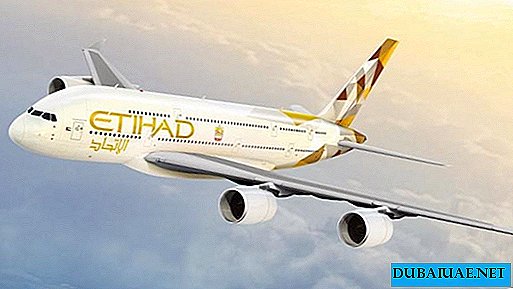This year, the exhibition "grew" by 5% compared to the last year: 2208 participants from 70 countries of the world. 10% more space was allocated for exhibition space than in 2007. In the first four hours since the opening of the exhibition, another record was set - attendance.
The main topics for discussion this year were the tourist boom in the region, investments in the development of tourism and hospitality, outbound tourism and the transition to low-cost tourism and flights, while maintaining the segment of rich tourists.
Middle East: a honeymoon of generous investment
 Investments in the development of the tourism sector in the region are growing day by day. A report prepared by the Fast Future & Global Futures & Foresight (GFF) group of experts on the Middle East Tourism Sector 2020, specially prepared for ATM 2008, states that more than US $ 1 trillion has already been invested in total and cash injections are expected over the next 12 years in the amount of US $ 3.63 trillion.
Investments in the development of the tourism sector in the region are growing day by day. A report prepared by the Fast Future & Global Futures & Foresight (GFF) group of experts on the Middle East Tourism Sector 2020, specially prepared for ATM 2008, states that more than US $ 1 trillion has already been invested in total and cash injections are expected over the next 12 years in the amount of US $ 3.63 trillion.
The main investors in the region are the UAE and Saudi Arabia. Nevertheless, representatives of the Saudi government who attended the exhibition said that the country was not yet ready to fully open up for mass tourism, although it was taking steps in this direction. For example, in April, the Saudi port city of Jeddah received the first cruise ship in the country's history. King Abdullah himself supervises the development of the country's tourism sector. Now in the Kingdom of Saudi Arabia, work is underway on projects worth US $ 184.4 billion. Emirates are more open and active. Dubai is already implementing projects with a total value of US $ 381.4 billion, the capital of the country - Abu Dhabi - US $ 131.3 billion.
According to experts, out of US $ 1 trillion of investments, US $ 120 billion went to the development of leisure complexes, such as theme parks and museums. The amount of US $ 218.3 billion was allocated for the creation of multi-purpose resorts, and US $ 611.9 billion was invested in residential and commercial real estate projects that will appear within these resorts. The exhibition featured all the largest tourism projects in the region. The largest project under development was King Abdulla Economic City (KAEC), which Saudi Arabia and the UAE are working on together, investing US $ 120 billion. The Dubai project of the world's largest tourist zone is slightly inferior to the plans. - Dubailand, which has absorbed US $ 110 billion investment. They are followed by the Kuwait City of Silk project with US $ 86 billion and the Arabian Canal in Dubai with US $ 61 billion investment.
Other countries in the region are less active. Against the general background, only Oman stands out, which is steadily developing tourism, but which does not have sufficient funds to implement large-scale and expensive projects. Nevertheless, the sultanate shows positive dynamics and is becoming a place of rest for an increasing number of tourists, primarily from the countries of the region.
Opening the exhibition, His Highness Sheikh Ahmed bin Saeed Al Maktoum, President of the Dubai Civil Aviation Committee and Chairman of the Board of Directors of Emirates Airlines, emphasized that “in order to maintain the growth of tourism in the region, all countries included in it need to work together so that proposals do not create unhealthy competition, but complemented each other and provided tourists with ample opportunity to choose. "
Dubai and Abu Dhabi: tourist boom is gaining momentum
 Emirates continue to be out of competition in the development of tourism. At the same time, the country is in a rather difficult situation, since it does not have a sufficient number of cultural and historical attractions. However, experts acknowledge that the UAE is doing everything possible and impossible to overcome problems, and more often than not, attempts are successful. The emirates have found their niche in an area where the most important factors for tourists are: proximity to the sea, a variety of entertainment and opportunities for quality shopping, as well as, truly, exclusive relaxation.
Emirates continue to be out of competition in the development of tourism. At the same time, the country is in a rather difficult situation, since it does not have a sufficient number of cultural and historical attractions. However, experts acknowledge that the UAE is doing everything possible and impossible to overcome problems, and more often than not, attempts are successful. The emirates have found their niche in an area where the most important factors for tourists are: proximity to the sea, a variety of entertainment and opportunities for quality shopping, as well as, truly, exclusive relaxation. 
The main generators of investment in the development of the tourism business in the UAE were recognized as the local holding Tatweer, engaged in large-scale real estate projects, which works on objects exceeding the value of US $ 131.3 billion, and the Abu Dhabi developer Aldar Properties, which has projects for US $ 71.1 billion Dubai-based developer Emaar Properties has invested US $ 16.5 billion in tourism and hotel projects in the UAE and more than US $ 130 billion in the region.
Inside the country, Dubai retains its leading position. At a press conference of the Department of Tourism and Commercial Marketing of Dubai (Dubai Department of Tourism & Commerce Marketing), it was announced that by 2010 the emirate will be ready to accept up to 10 million tourists a year, which is 3 million more than in 2007. By 2015, this figure is planned to be increased to 15 million tourists annually.
It is planned to bring the number of hotels and serviced apartments to 488 units in the next two years, and the number of hotel rooms - to 64179. According to statistics for 2007, the emirate had 452 hotels and serviced apartments and 51,168 rooms. The capital of Abu Dhabi said that there is no competition between Dubai and Abu Dhabi, since the emirates work in different niches and do it together.
According to Sheikh Sultan bin Tahnun Al Nahyan, Chairman of the Department of Tourism of Abu Dhabi (Abu Dhabi Tourism Authority, ADTA), the capital of the UAE focuses on attracting a "five-star" category of tourists and leaves Dubai with mass tourism, which is more active, but spends on vacation in times less money.
Abu Dhabi carefully studied the experience of India and North Africa, and then the emirate adopted a "guided and progressive model for the development of the tourism industry."
In accordance with the five-year plan, the emirate of Abu Dhabi plans to increase the number of hotel rooms to 25,000 and receive up to 2.7 million tourists a year. At the moment, the emirate has 12,000 rooms and receives a little more than 2 million tourists. ADTA also plans to operate by 7 offices in various regions by 2012, including Austria, China and Italy. Now the department has 3 offices: in the UK, Germany and France.
Abu Dhabi is simultaneously working on several large-scale tourism projects - this is the Formula 1 track on Yas Island, the Desert Islands Resort on Bani Yas Island, and Qasr Al Sarab Resort in the desert oasis of Liva. No less important is the development of Saadiyyat Island, where branches of famous museums - the Paris Louvre and the Guggenheim Museum - will be opened. Other UAE emirates are developing at a much more modest pace. Among them, the emirate of Fujairah, known for its favorable microclimate, is noticeably distinguished, where the numbers of tourist activity are growing "by leaps and bounds", and well-known hotel chains are building and opening new "five-star" hotels. However, the contribution of Fujairah to the piggy bank of emirate tourism is still small in monetary terms.
Middle East: Significant Outbound Tourism Growth
 As the results of the last year and the discussion of the panel of experts at the exhibition showed, tourists from the region of the Middle East are increasingly leaving the country to rest. The Travel Survey 2008 study published at the exhibition, prepared by the Arabian Business group, showed that four out of five residents of countries in the region visited at least two countries outside the region last year.
As the results of the last year and the discussion of the panel of experts at the exhibition showed, tourists from the region of the Middle East are increasingly leaving the country to rest. The Travel Survey 2008 study published at the exhibition, prepared by the Arabian Business group, showed that four out of five residents of countries in the region visited at least two countries outside the region last year.
More than a quarter of respondents indicated that they were in more than six countries in a year. Thus, eight out of ten residents of the Middle East travel every six months using air services. A quarter of respondents are on board aircraft much more often - every five weeks.
Residents of Oman were recognized as the most potential group for outbound tourism: they expressed a desire to travel long distances to two to five countries a year. The Omanis are followed in descending order by the inhabitants of Qatar, Bahrain, Saudi Arabia and Kuwait.
Residents of the Emirates go on vacation much less often, but in the business tourism class they are superior to everyone, including Saudi Arabia, which is much larger in population. At one of the "round tables" that were held on all days of the exhibition, representatives of foreign exhibitors and guests actively discussed the prospects for the development of outbound tourism in the region. The main parameters for choosing a suitable destination for all residents of the region are comfort for families and the cultural heritage of the country or a specific place. Least of all are they interested in nightlife and outdoor activities. At the same time, all experts agreed that Middle Eastern tourists are willing to pay in full and do not perceive vacation costs as a determining factor.
Therefore, it is not surprising that the presence of foreign countries increased by 5% at ATM-2008: representatives from all continents came to Dubai, and for the first time all countries of the region were presented at the exhibition. Also, for the first time in the region, more than 90 new exhibitors presented their tourism products. ATM debutants include Bangladesh, the Philippines, Djibouti, Georgia, Senegal and Nepal.
Aviation: new routes, planes and airlines
 The aviation sector has always been and remains the main ally, but also an opponent of the development of tourism, so he was given special attention during the ATM-2008. The two largest Emirates airlines - Dubai's Emirates Airlines and Abu Dhab Etihad Airways appeared at the exhibition with good and bad news.
The aviation sector has always been and remains the main ally, but also an opponent of the development of tourism, so he was given special attention during the ATM-2008. The two largest Emirates airlines - Dubai's Emirates Airlines and Abu Dhab Etihad Airways appeared at the exhibition with good and bad news.
The bad news was about the next delay in the supply of new aircraft, which hinders the development of airlines and their discovery of new directions. They also discussed the need to expand airspace capacity in the region, which has become urgent and requires an early resolution. There was more good news. Both airlines showed positive results of the past fiscal year and grew both in breadth and in quality.
Dubai-based Emirates Airlines has confirmed its readiness to open the Dubai-New York route, which will be operated by the Airbus 380, the largest passenger airliner in the world and the first in the airline's fleet. The first Emirates flight on the double-deck Airbus 380 will fly from Dubai to New York International Airport. John F. Kennedy on August 1 of this year. The 14-hour flight will also be the first commercial flight of the A380 in the United States.
UAE's national airline Etihad Airways will be the first airline in the Gulf region to operate scheduled flights to Belarus, with the opening of the city of Abu Dhabi - Minsk direct flight on August 5 this year. Etihad will fly to Minsk twice a week - on Tuesday and Thursday. The third daily flight on Saturday will be added in October this year. The route will be serviced by the new Airbus 319.
A special topic for exhibitors was the announcement of the addition of low-cost airlines to the family in order to fully cover the demand in the region. At the same time, experts noted that the concept of "budget" in the region is completely different than in the whole world, that is, the price for this type of transportation is higher than the accepted qualifications.
By the decree of the ruler of Dubai, Sheikh Mohammed bin Rashid Al Maktoum, Dubai is going to open its own low-cost airline under the patronage of the state-owned company Emirates Group. The new airline, the name of which has not yet been determined, will compete with the only low-cost airline in the Emirates Air Arabia, based in Sharjah, and make flights only for distances up to four and a half hours of flight time. Its fleet will include Boeing 737 and Airbus A320 class aircraft. The Qatar airline Qatar Airways announced plans to start low-cost transportation at the exhibition. Akbar Al Baker, head of Qatar Airways, said that "he still cannot get used to the need for budget transportation, but he supports the idea because it creates demand."
At the exhibition, airport achievements were also shown, among which stood out the grandiose Dubai project - Al-Maktoum International Airport (Dubai World Central), which is being built in the Jebel Ali area and should begin to work in full force already in 2017. It will become the largest airport in the region and one of the largest in the world.
Emirate Ajman announced the construction of his own international airport. It will be opened in the town of Al Manama, 50 km from Dubai, and will occupy an area of 650 hectares. Construction work will begin after the new year. Upon completion of work, in 4-5 years, Ajman International Airport will meet a million passengers annually and handle 400 thousand tons of cargo. In the area of the airport, which will accept all types of passenger liners, hotels, shopping centers, commercial and residential buildings will be built.
Abu Dhabi Airports Company spoke about the development of a Free Economic Zone (SEZ) project at Abu Dhabi International Airport. The project will be implemented in several stages. The SEZ at Abu Dhabi Airport will occupy almost 4 million square meters. m. area. The zone is planned to be divided into separate sectors, each of which will cover a specific business area. Also in the zone there is a small industrial area where environmentally friendly production will operate.
The project to create a free economic zone at the Abu Dhabi airport is part of a larger airport zone redevelopment project, for which the emirate government has allocated US $ 6.8 billion. After the project is completed, Abu Dhabi international airport will become one of the largest in the world.
The exhibition working group, the government of Dubai and exhibitors from around the world were pleased with ATM-2008. Over 40% of the exhibition space has already been reserved for the next year, and Dubai again expects growth in attendance and good news.








